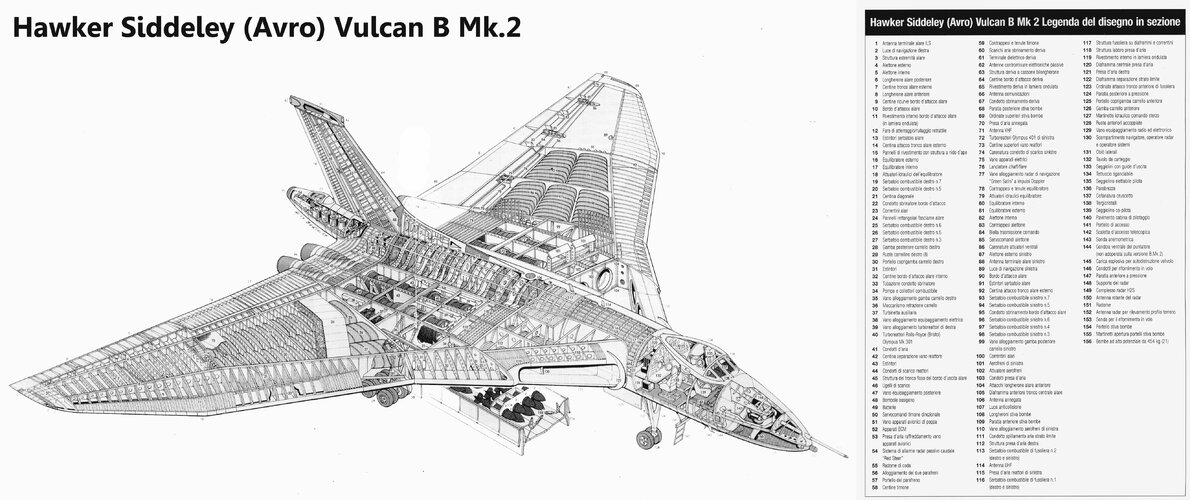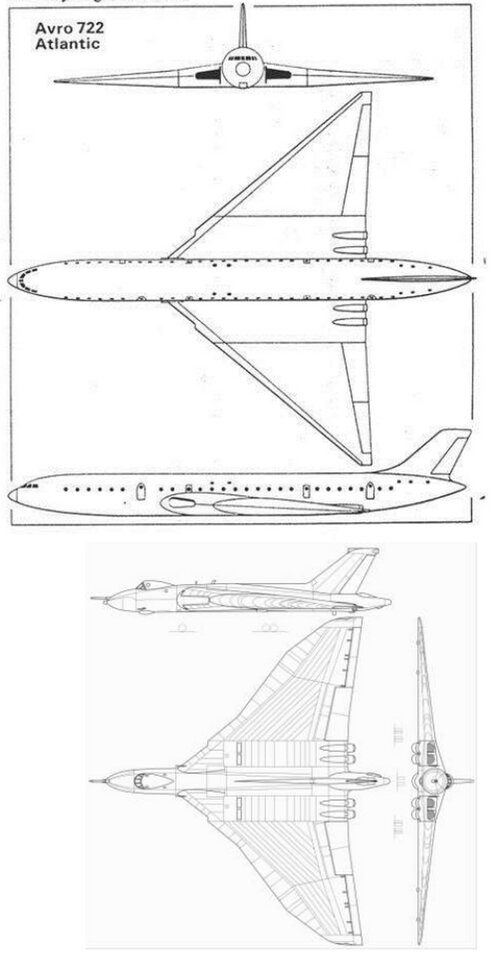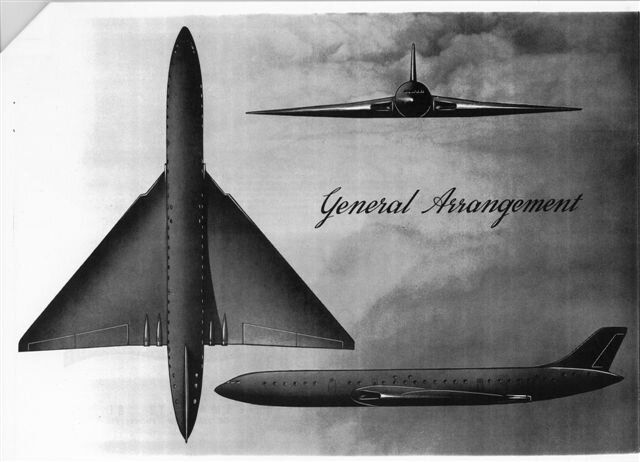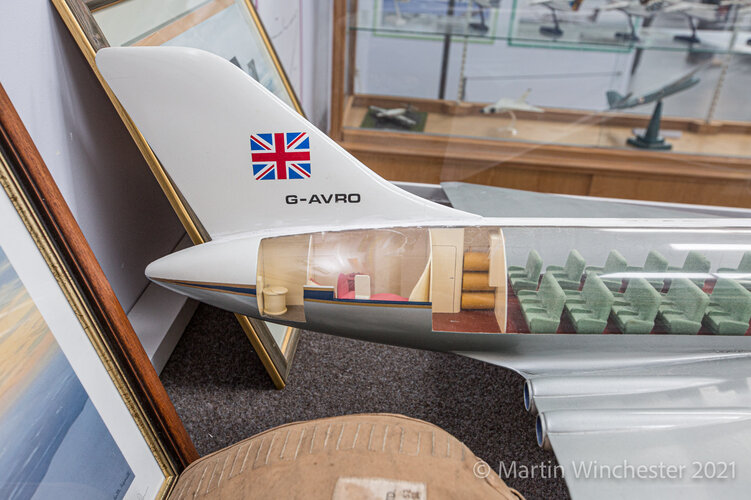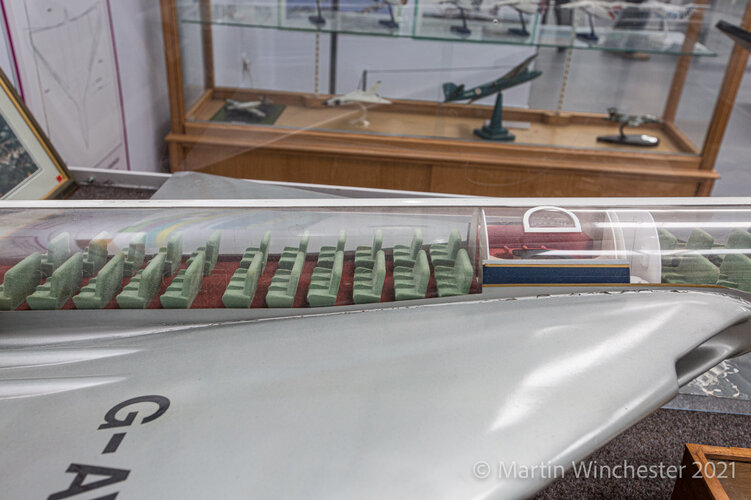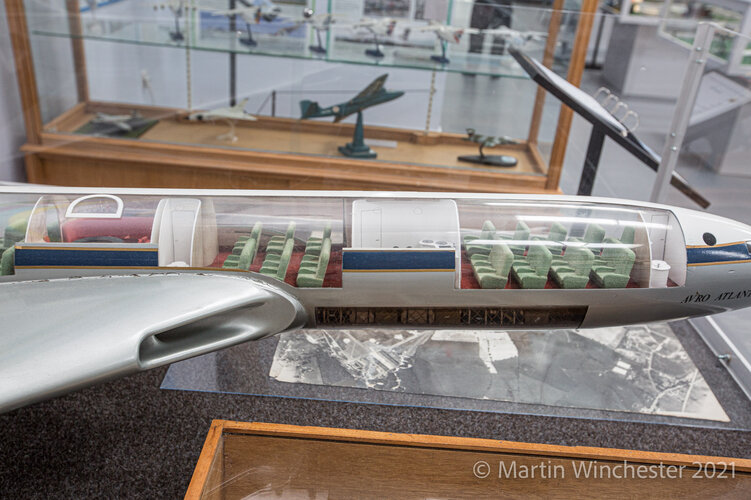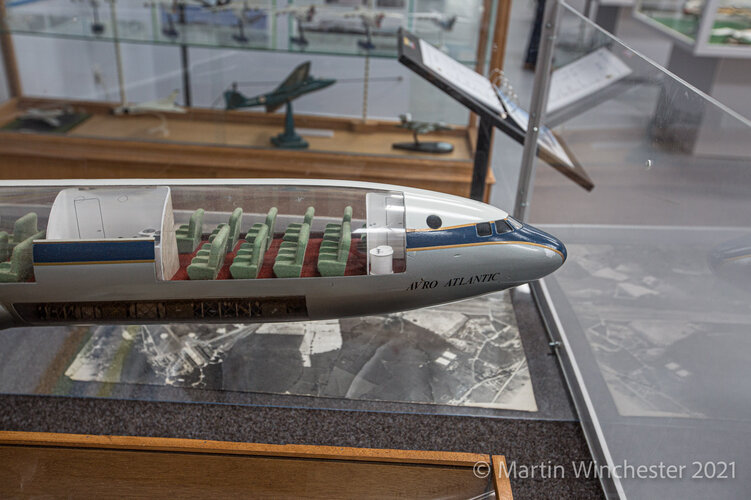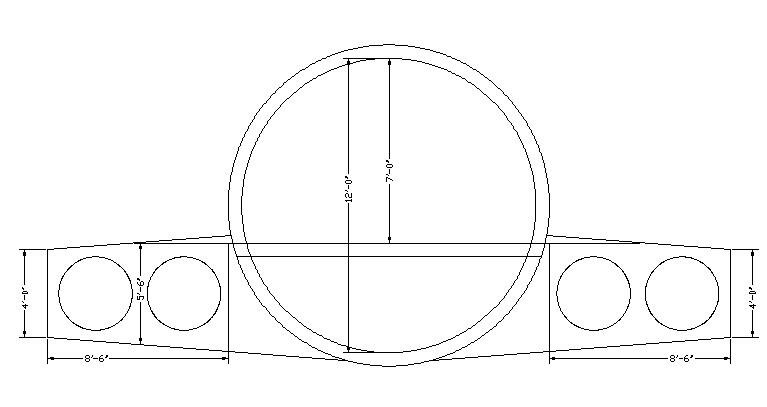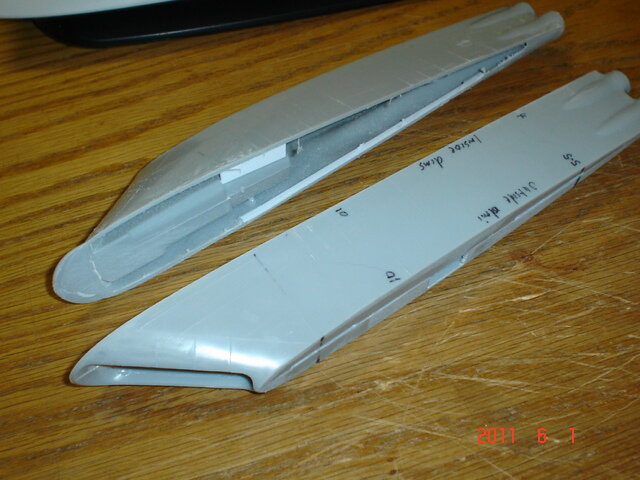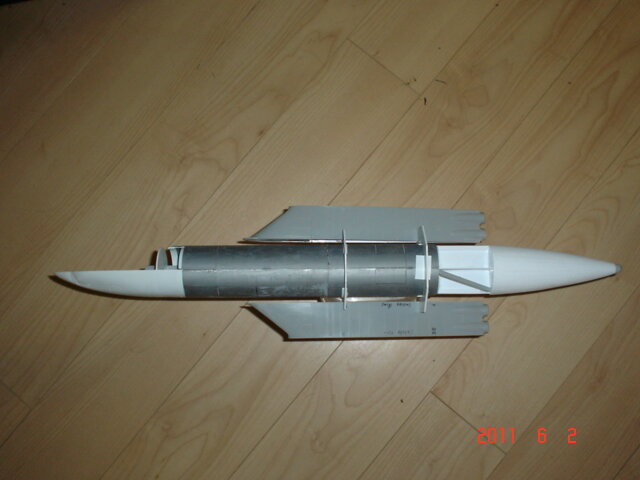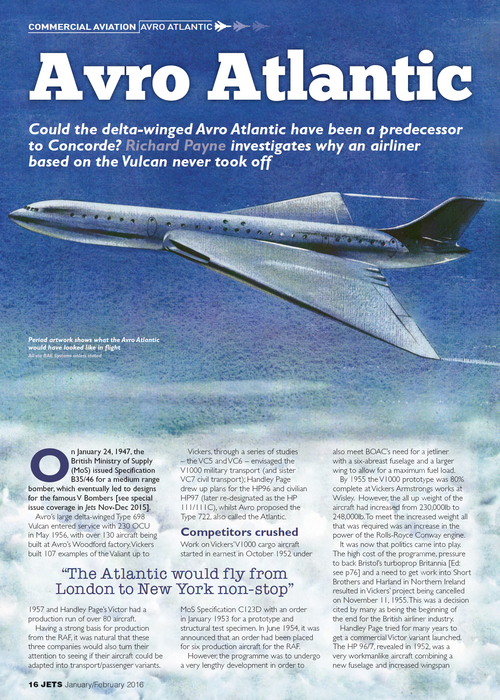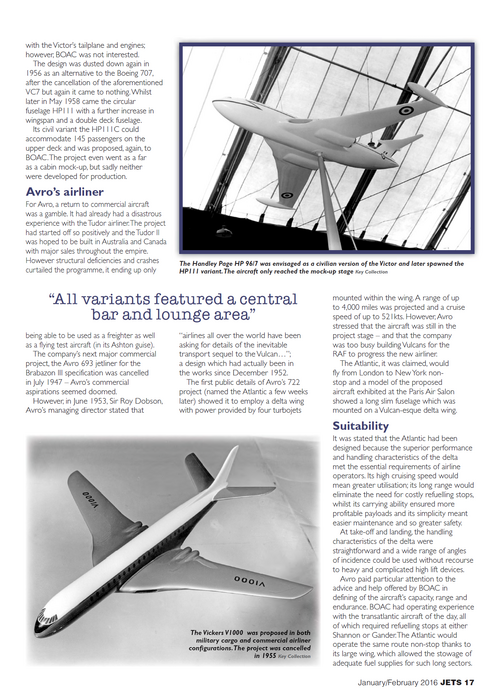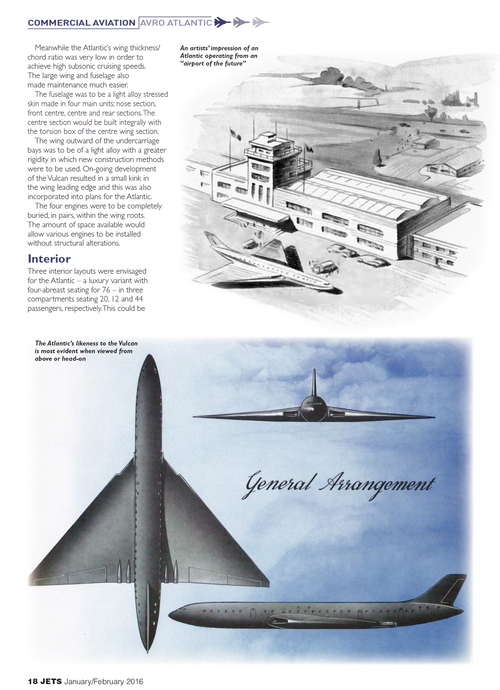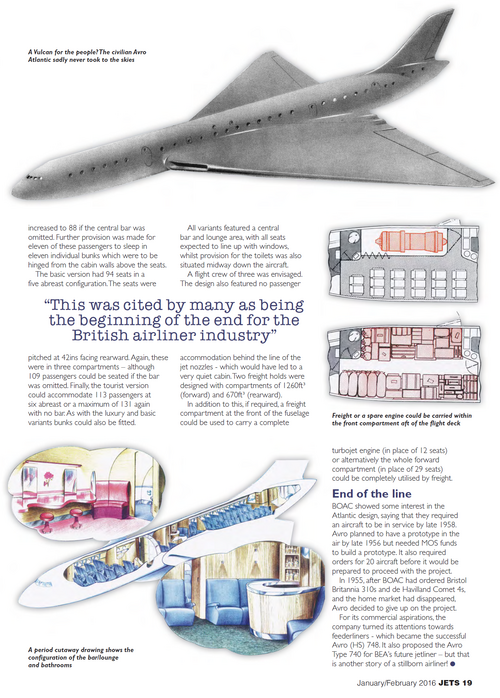Well, by the time Avro would've got around to the Atlantic, the Vulcan was already using the small leading edge extensions, which is why I'm building my model with them (see photos further back in the thread Reply #49)
You are using an out of date browser. It may not display this or other websites correctly.
You should upgrade or use an alternative browser.
You should upgrade or use an alternative browser.
Avro Atlantic
- Thread starter The Wooksta!
- Start date
blackkite
Don't laugh, don't cry, don't even curse, but.....
- Joined
- 31 May 2007
- Messages
- 8,819
- Reaction score
- 7,718
The Flight cutaway is the more accurate one: you don't want long jet exhaust pipes, they cause worse losses than long intake pipes.
It matches these photos of an engine removal on a Vulcan.
It matches these photos of an engine removal on a Vulcan.
blackkite
Don't laugh, don't cry, don't even curse, but.....
- Joined
- 31 May 2007
- Messages
- 8,819
- Reaction score
- 7,718
http://aviationtrivia.blogspot.com/2009/10/based-on-lay-out-and-delta.html
"Based on the layout and delta configuration of the Avro Vulcan, the Avro Type 722 Atlantic was first proposed in June 1953. The original configuration of the Atlantic had the four engines next to the fuselage as in the Avro Vulcan, but as engineering and design work proceeded, by the time of the Farnborough Air Show in 1953 the engine pairs were moved outward halfway on the wings.
Engines were to have been in the same class as either the Olympus engines used on the Vulcan or the new Rolls-Royce Conway turbofan. The fuselage of the Atlantic was circular in cross-section with a diameter of 12.5 feet which allowed five-abreast seating for up to 120 passengers in rear-facing seats. The cabin was divided in two by a centrally-located galley which could be augmented by a bar/lounge area as well. With a length of 143 feet and a wingspan of approximately 119 feet, the Avro Atlantic would have been able to carry its passengers at a range of nearly 6,000 miles at 40,000+ feet at speeds like that of the Avro Vulcan.
Despite the publicity efforts of Avro, no interest was forthcoming in the Atlantic.
Source: Avro Vulcan: Britain's Famous Delta-Wing V-Bomber by Phil Butler and Tony Buttler. Aerofax/Midland Publishing, 2007, p55. 2"
"Based on the layout and delta configuration of the Avro Vulcan, the Avro Type 722 Atlantic was first proposed in June 1953. The original configuration of the Atlantic had the four engines next to the fuselage as in the Avro Vulcan, but as engineering and design work proceeded, by the time of the Farnborough Air Show in 1953 the engine pairs were moved outward halfway on the wings.
Engines were to have been in the same class as either the Olympus engines used on the Vulcan or the new Rolls-Royce Conway turbofan. The fuselage of the Atlantic was circular in cross-section with a diameter of 12.5 feet which allowed five-abreast seating for up to 120 passengers in rear-facing seats. The cabin was divided in two by a centrally-located galley which could be augmented by a bar/lounge area as well. With a length of 143 feet and a wingspan of approximately 119 feet, the Avro Atlantic would have been able to carry its passengers at a range of nearly 6,000 miles at 40,000+ feet at speeds like that of the Avro Vulcan.
Despite the publicity efforts of Avro, no interest was forthcoming in the Atlantic.
Source: Avro Vulcan: Britain's Famous Delta-Wing V-Bomber by Phil Butler and Tony Buttler. Aerofax/Midland Publishing, 2007, p55. 2"
Attachments
As I explained further up the thread, I was in contact with Mike Meehan who worked on the brochure for the Atlantic. What he told me was that there had been some erroneous information published and when I told Tony Buttler that, he asked for Mike's contact address, which I gave him. I'm not sure what happened after that though, but a few years ago Mike died. Mike had told me this 3-View below was the last offering and I'm using it to build my model.
Attachments
zebedee
ACCESS: Secret
- Joined
- 8 January 2006
- Messages
- 1,612
- Reaction score
- 763
Not only that, but they can build up back pressure that makes starting the engines that much more complicated. You wouldn't believe the iterations on the TPE331-10 engine computer (box?) to get proper starting on the Swearigen Merlin and Metro while neither Aero Commander, CASA, nor Mitsubishi had any problems since they all had short exhaust pipes. Damn, that takes me back some 43 odd years (some odder than others).The Flight cutaway is the more accurate one: you don't want long jet exhaust pipes, they cause worse losses than long intake pipes.
It matches these photos of an engine removal on a Vulcan.
- Joined
- 20 January 2007
- Messages
- 953
- Reaction score
- 1,143
It seems to be a sensible business decision to spend some money scheming civil variants of expensive large structure.
1953: all 3 V-Bombers have passed from DO into Flight Test. BOAC has Comet 1 in Service, Comets 2 and 3 coming along. US has nothing yet. Clear opportunity. But...
It is conventional wisdom now, and I suppose then, that successful (economic, reliable) airliners do not stem from bombers. BOAC would say: see Stratocruiser, its engine and systems. If that is so, if every Module 101 for Design courses says so...
Why did GR.Edwards attempt VC7-from-Valiant, knowing the weight challenge? Why did Sir Roy Dobson allow Avro to waste their time? or Sir Fred HP?
1953: all 3 V-Bombers have passed from DO into Flight Test. BOAC has Comet 1 in Service, Comets 2 and 3 coming along. US has nothing yet. Clear opportunity. But...
It is conventional wisdom now, and I suppose then, that successful (economic, reliable) airliners do not stem from bombers. BOAC would say: see Stratocruiser, its engine and systems. If that is so, if every Module 101 for Design courses says so...
Why did GR.Edwards attempt VC7-from-Valiant, knowing the weight challenge? Why did Sir Roy Dobson allow Avro to waste their time? or Sir Fred HP?
Last edited:
Stratocruiser suffered from engine problems. But lots of civilian designs successfully used bomber engines (and later civ designs would successfully use V-bomber engines Conway and Olympus), so Stratocruiser was not in itself a reason not to try.
The weight issues of VC7 weren't unique to bomber conversions: clean-sheet civilian designs have been known to suffer from this as well, especially at times of massive change (from piston to jet, to pressurized cabins, massive increase in size over anything developed previously etc., while still having to use manual design methods instead of using computer models to predict performance before you've committed to cutting metal).
The V-bombers were perhaps the last generation of bombers that could be used as the basis for airliners: they were designed for long range at high altitude. What scuttled the V-airliners was lack of money (from the RAF, which these were pitched at first, and from the British national airlines).
The weight issues of VC7 weren't unique to bomber conversions: clean-sheet civilian designs have been known to suffer from this as well, especially at times of massive change (from piston to jet, to pressurized cabins, massive increase in size over anything developed previously etc., while still having to use manual design methods instead of using computer models to predict performance before you've committed to cutting metal).
The V-bombers were perhaps the last generation of bombers that could be used as the basis for airliners: they were designed for long range at high altitude. What scuttled the V-airliners was lack of money (from the RAF, which these were pitched at first, and from the British national airlines).
kaiserd
I really should change my personal text
- Joined
- 25 October 2013
- Messages
- 1,657
- Reaction score
- 1,726
The primary reasons for the failure of the V-1000/ VC-7 were not as simple as lack of money (though the relative lack of previous research and engineering experience versus US industry, which would have required more spending earlier, was a critical factor).
It’s the classic UK post war aviation story of technical and economic overreach aided by mismanagement at industry, ministry and political levels which later becomes a finger pointing/ blame deflecting exercise and which ends up as a stab-in-the-back narrative for those with particular biased axes to grind (with biased axes being some of the most difficult and time consuming axes to grind).
It’s the classic UK post war aviation story of technical and economic overreach aided by mismanagement at industry, ministry and political levels which later becomes a finger pointing/ blame deflecting exercise and which ends up as a stab-in-the-back narrative for those with particular biased axes to grind (with biased axes being some of the most difficult and time consuming axes to grind).
- Joined
- 6 September 2006
- Messages
- 4,838
- Reaction score
- 9,478
It seems to be a sensible business decision to spend some money scheming civil variants of expensive large structure.
1953: all 3 V-Bombers have passed from DO into Flight Test. BOAC has Comet 1 in Service, Comets 2 and 3 coming along. US has nothing yet. Clear opportunity. But...
It is conventional wisdom now, and I suppose then, that successful (economic, reliable) airliners do not stem from bombers. BOAC would say: see Stratocruiser, its engine and systems. If that is so, if every Module 101 for Design courses says so...
Why did GR.Edwards attempt VC7-from-Valiant, knowing the weight challenge? Why did Sir Roy Dobson allow Avro to waste their time? or Sir Fred HP?
The simple answer is; because of OR.318 and the Air Staff's desire for a jet transport to support the V-Bomber force. The MoS had stipulated it must be based on an existing design so naturally DH sent in a Comet, Bristol a Britannia, Saro the Princess and everyone else threw in V-Bomber derivatives (even the Sperrin).
It was therefore natural for the companies to think "what if we replaced the troop seats with airliner seats and added some sound insulation?" It looked like an easy win, whoever won OR.315 (technically OR.315 was issued after the selection process - hence the bog up it became) had a ready made long-range jet airliner.
Sadly they overlooked some major factors, which the MoS assessments picked up even before BOAC looked at the offerings:
- noise, even for troop carriers the noise in the rear cabins next to the exhausts was too high
- the cabin widths were the wrong size, some were too cramped and others too wide for four-abreast seating yet not wide enough for five-abreast. Boeing of course did triple diameter changes on its 367-80/KC-135/707. British manufacturers (and MoS and Treasury) were loath to fork out on two sets of jigs.
The cabin ceilings were too high too, again Boeing had this issue with the 747, being developed from CX-HLS.
- the cabin floors were strengthened to lug around jeeps and Olympus engines, so structure weight was always going to be a problem
- nobody had actually asked what BOAC wanted, industry just wanted to flog them a civilianised OR.315 transport (the MoS also rubbing its hands regarding amortisation of costs). BOAC had no real desire to pick up the V.1000 (or any of the OR.315 competitors), the VC.7 was largely a Vickers charade. Edwards made a lot of noise about losing the trans-Atlantic airliner market but really Vickers having designed the Viscount from scratch should have realised a lash-up job was never going to work.
The Avro 718 (Atlantic) was quickly eliminated due to take-off performance, the choice was H.P.96 or the Vickers 716. The former had better operating economics, the latter more growth potential. BOAC felt the 716 was the better choice, the RAF followed suit to enable a common design and begat the V.1000. BOAC was nervous and quickly jumped to the Comet 3.
My article on OR.315 which goes into more depth can be found here:
https://www.secretprojects.co.uk/conversations/v-1000.25990/#convMessage-28245
The main problem with the Atlantic as all the concept drawings and diagrams I've seen show, is the front spar which protrudes above the cabin floor. This spar is about a 3rd of the way down the fuselage from the front, and effectively prevents the aircraft being used as a transport using cargo pallets. Quite obvious when you're building a model of it.
But I've discovered that it doesn't have to be there, but the reason it is there is because Avro wanted to use as much of the Vulcan wing as possible. But the spars in the Vulcan wing are there because of the requirement for the bomb bay, and the spars are also the front and back ends of the bomb bay. The discovery (or 'light bulb moment') I had, was the Atlantic didn't need a bomb bay and so the front spar didn't need to be where it is. It could have had multiple spectacle spars in it's place with the main front spar actually being at the engine fronts.
In this CAD sketch I did, I found the depth of the wing chord where the engine fronts are located was actually close to top of cabin floor to bottom of fuselage. Of course it could have been the quirks of the kit I was using, the old Airfix Vulcan. Middle photo shows the inner wing cut off the fuselage and in the last photo you can see I made a couple of jig pieces to hold the inner wing in place to the fuselage so I could develop the wing fuselage connection, the front jig is where the engine fronts are -- at least on the kit it is but the Flight cutaway drawings I used for reference seem to confirm this.
But I've discovered that it doesn't have to be there, but the reason it is there is because Avro wanted to use as much of the Vulcan wing as possible. But the spars in the Vulcan wing are there because of the requirement for the bomb bay, and the spars are also the front and back ends of the bomb bay. The discovery (or 'light bulb moment') I had, was the Atlantic didn't need a bomb bay and so the front spar didn't need to be where it is. It could have had multiple spectacle spars in it's place with the main front spar actually being at the engine fronts.
In this CAD sketch I did, I found the depth of the wing chord where the engine fronts are located was actually close to top of cabin floor to bottom of fuselage. Of course it could have been the quirks of the kit I was using, the old Airfix Vulcan. Middle photo shows the inner wing cut off the fuselage and in the last photo you can see I made a couple of jig pieces to hold the inner wing in place to the fuselage so I could develop the wing fuselage connection, the front jig is where the engine fronts are -- at least on the kit it is but the Flight cutaway drawings I used for reference seem to confirm this.
Attachments
Last edited:
foiling
ACCESS: Secret
- Joined
- 12 August 2007
- Messages
- 367
- Reaction score
- 137
What is the name & author of this delightful little book?From a slim Dutch book on modern aircraft ~1950 (also included general layout line drawings)
Similar threads
-
-
-
Operation Black Buck raid and the Avro Vulcan
- Started by Pioneer
- Replies: 6
-
Avro Vulcan flare (and other countermeasures) dispensers - any information?
- Started by Flame2512
- Replies: 27
-
O

